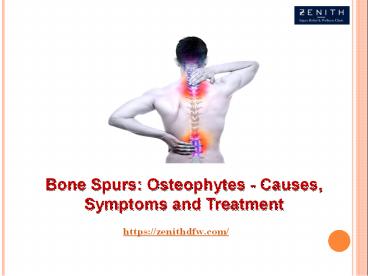Bone Spurs: Osteophytes - Causes, Symptoms and Treatment - PowerPoint PPT Presentation
Title:
Bone Spurs: Osteophytes - Causes, Symptoms and Treatment
Description:
Do you know what happens when bone spurs form in the lumbar spine? Here is a detailed article that talks about symptoms of bone spurs, causes of bone spurs, and how to treat them. – PowerPoint PPT presentation
Number of Views:7
Slides: 6
Provided by:
Username withheld or not provided
Category:
Medicine, Science & Technology
Tags:
Title: Bone Spurs: Osteophytes - Causes, Symptoms and Treatment
1
Bone Spurs Osteophytes - Causes, Symptoms and
Treatment
https//zenithdfw.com/
2
Bone Spur Osteophytes Are you are
experiencing pain or weakness in your back? You
may wonder it might be due to overexertion or
from osteoarthritis. Sometimes osteoarthritis may
also lead to the development of bone spurs in
shoulder, neck, and back joints. Bone spurs
develop as hard growths on the edges of bones and
around joints. Some bone spurs may not cause pain
but some of them may lead to back and neck
pain. Bone spurs are smooth, bony developments,
mostly close to joints. Over the period they
develop arthritis, joint pain, or joint damage.
The feet, hands, knees, and spine regularly
foster bone spurs. Following a healthy lifestyle
can postpone signs like pain, solidness, and
restricted movement. When these bone spurs
develop in your spine they are referred to as
osteophytes, degenerative joint disease,
degenerative disc disease, osteoarthritis, or
spinal decay. Bone spurs or osteophytes develop
at the point of bones meeting each other, i.e. in
your joints. They can also develop on the bones
of your spine. Surgery along with medication and
physical therapy helps in recovery.
3
Why Do Bone Spurs Develop? Bone spurs are most
common in people 60 years or older, but younger
people can get them, too. Osteophytes indicate
the age of the problem, not the age of the
person. Assuming that the spinal joint moves
twisted and becomes stuck, the clock begins
ticking. It might require quite a while before
the main pointer, a roughened edge on the
vertebra, starts to appear. The spine consists of
33 bones to protect the spinal cord. The discs
are filled with gel between the bones serve as
shock absorbers. The discs also allow us to bend
forward and backward and twist our backs in a
variety of directions. There are opening behind
each disc and under each joint that allows a part
of nerve roots to pass the spinal cord known as
the foramen. The spinal cord will go to other
parts of the body. Bone spurs can be a problem if
they develop in the openings for the nerve roots.
They make the space narrower and press on the
nerve referred to as foramen stenosis.
4
- Symptoms Of Bone Spurs
- Knee Bone spurs in your knee can make it painful
to expand and twist your leg. - Spine The bone spurs on your vertebrae can
narrow the space that contains your spinal cord.
These bone spurs can pinch the spinal cord or its
nerve roots causing cause weakness or numbness in
your arms or legs. - Hip Bone spurs can make it painful to move your
hip, even though you could feel the pain in your
knee. The bone spurs can decrease the scope of
movement in your hip joint. - Some of the other symptoms include
- Pressure on nearby nerves.
- Restrict movement.
- Rub against other bones or tissues.
- Crooked or bumpy areas, especially in the fingers
or toes. - Numbness and weakness, especially in the legs if
the spine has spurs. - Pain near the affected joint, like heel pain.
- Get More Information Click Here
5
Contact Us
Website https//zenithdfw.com/ Contact No.
(469) 590-1212































